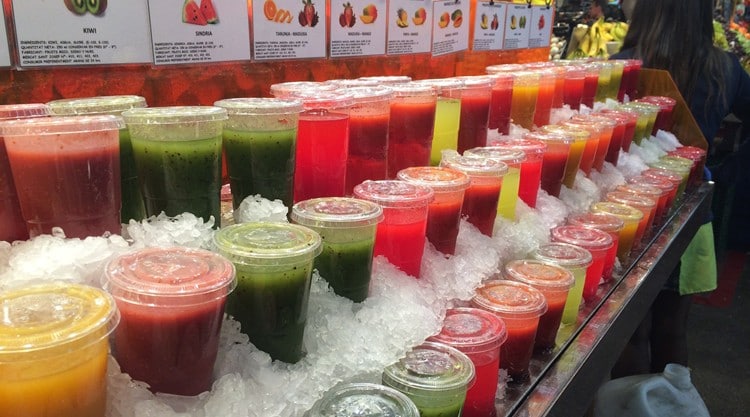I love to watch people, especially when traveling abroad. A few years ago, I was sitting on a bench in a bustling Southeast Asian city while sipping a mango smoothie when I noticed a man unload a huge block of ice on the side of the road. It struck me as odd, this massive ice block, the size of a desk, was just sitting under the sun on the pavement. “What was it for?” I wondered. The street was filled with all sorts of characters that morning; chickens, rats and stray dogs along with multiple street vendors, meat carcasses hanging from stalls and pantless children running around. I sat there for well over a half an hour, enjoying the scenery and finishing my delicious smoothie, when I noticed the lady who sold me my sweet smoothie approach the block of ice with a knife. Suddenly, I felt a little unsettled and I was hoping she wouldn’t do what she began to do. She hammered away at the ice block and collected the pieces to use in her tasty smoothie. Yikes!
Travelers diarrhea can affect all travelers. It’s an unfortunate fact. Everyone is at risk as bacterias, viruses and parasites can be found everywhere, even on the grounds of the most luxurious all-inclusive resorts or in the ice chips of delicious mango smoothie. No one is safe. As a travel health nurse, it is my job, and that of my team, to give you advice on how to reduce your chances of having diarrhea while abroad.
Washing your hands frequently is imperative, no matter where you find yourself in the world. Proper hand hygiene is one of your first and best defenses against germs, especially after using a washroom and before eating. It is also advised to wash your hands after using public transportation, visiting a museum, or even shopping at the market. You may find that excessive, but think about it; you touch the banister at the train station and then you touch your face, or apply some lip balm or even place a piece of gum in your mouth. You have now transferred the germs from that railing into your mouth. Carrying around a small bag of sanitary wipes or a tube of antibacterial hand sanitizer no longer seems so crazy, now does it?
Careful food and beverage selection tips are also commonly shared, however these tend not to be effective simply because people don’t like to follow them. Advising travelers not to partake in the street food culture while traveling throughout Southeast Asia is just silly. They are just unrealistic expectations. Research has actually shown that even if people adhere to these strict precautions, the main factors actually lie with the hotel and restaurant staff. Restaurant hygiene is one of the major players in the transmission of travelers’ diarrhea. How food is handled and prepared behind the scenes plays a larger role in whether you’ll be falling ill after eating their food than anything else. Traveler’s diarrhea in most circumstances is out of the control of the traveler, so, what to do?
More and more, we, travel health care professionals, are suggesting Pepto-Bismol® as a preventative measure against traveler’s diarrhea. Although primarily advertized as a treatment for diarrhea, the active ingredient bismuth subsalicylate (BSS) has demonstrated the ability to reduce contracting traveler’s diarrhea by nearly 50%! Ask your healthcare professional about the dosage details and if you are eligible to take Pepto-Bismol® this way, as there is a long list of allergies, medications and conditions that are important to carefully consider before take this medication.
Is there a vaccine for traveler’s diarrhea? Yes, there is. The vaccine Dukoral, initially created for the prevention of Cholera, has shown moderate efficacy in preventing one strain of traveler’s diarrhea, enterotoxigenic E. coli. Studies have shown that this one strain causes approximately 30% of the bacterial traveler’s diarrhea in most regions of the world, aside from Southeast Asia. Although the efficacy is moderate at best, it is something worth considering when going on vacation.
What about probiotics? The verdict is still out on this one. While research has shown probiotics to reduce travelers’ diarrhea in a small number of people, nothing conclusive has been found. The studies conducted so far have predominantly been in relation to diarrhea after having taken an antibiotic, therefore more research is needed.
There’s an app for that! No, really, there is an app. The CDC, Center for Disease Control in the US, created a user friendly app, “Can I eat this?”, a guide to eating abroad. I tested this out myself and although some of the recommendations may not be realistic and easily implemented, it does provide you with some helpful tips. Check it out here: https://wwwnc.cdc.gov/travel/page/apps-about#canieat
Preventative measures are incredibly important, however knowing what to do and being equipped with prescription antibiotics and the right over-the-counter medications should you become ill are absolutely necessary and could very well save your vacation!
Stay tuned for our next posting, Part 2 on Travelers’ diarrhea where I’ll talk about what to do and your treatment options.

